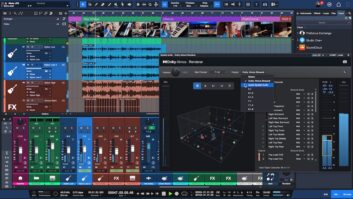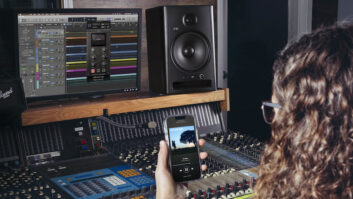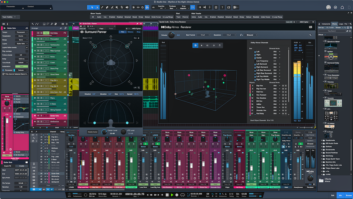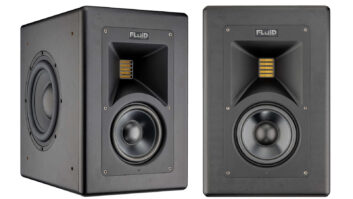One of the first things I learned as a neophyte engineer back in the early ’80s was that near-field monitors should always be placed so that their tweeters point directly at your ears (or, alternatively, slightly behind your seated position). Well, throw that theory out the window for the next 10 minutes while you read this review. New Audio’s Spatial One monitors ($1,400 a pair, $700 each) take an entirely new approach to sound reproduction.
LET’S DIFFUSE THE SITUATION
Spatial One’s 1-inch inverted-cone Kevlar tweeter is mounted underneath a hood of sorts so that it fires downward at a slot diffusor that’s mounted at roughly a 45-degree angle on the front face of the monitor’s cabinet. The theory behind this unusual design is that the diffusor creates a planar sound field (instead of point-source propagation) at the speaker, thereby lessening the first angle of incidence reflections off of the control room’s walls. The purported result is the elimination of phase anomalies in early acoustic reflections (producing greater clarity), not to mention a wider sweet spot.
Measuring 16×7.5×12 inches (H×W×D) and weighing 27 pounds each, each cabinet is fashioned from 17mm-thick MDF. In addition to the tweeter, the two-way passive monitor sports a 6.5-inch polypropylene woofer with rubber surround and snap-on dust cover. A rear bass port, two inches in diameter, is flared on both ends to reduce wind coloration. Five-way, solid-brass binding posts accept heavy-gauge wires. An integrated carrying handle (embedded behind the tweeter’s hood) can be used with the company’s optional Scaffolding Clamp Mounts to fly the monitor from a truss. Alternatively, three supplied screw-in floor spikes can be used to decouple each cabinet from a stand.
Maximum short-term power handling is rated at 150 watts. Sensitivity at 1 meter from the speaker is a respectable 88 dB @ 1 watt. The stated frequency response is 59 to 18k Hz, ±3 dB, with 10dB down points at 50 Hz and 20 kHz, and a tweeter/woofer crossover frequency of 2.7 kHz. The Spatial One’s polar response at 10 kHz is specified to be ±120 degrees, corroborating theoretical claims of a wide sweet spot inherent to the diffuse tweeter design.
TESTING…1, 2, 3
I placed a pair of Spatial Ones in my Acoustic Sciences Corporation (ASC) ATTACK Wall, a modular and contiguous arrangement of tube traps that wrap around the back side of my mixer to tighten up the impulse response at the front of the control room. Each Spatial One sat on a 16-inch-diameter ASC Monitor Trap (part of the ATTACK Wall) that, along with the monitors’ installed floor spikes, decoupled the speakers to prevent audible resonances. Because the Spatial One is rear-ported, I removed the ATTACK Wall’s top monitor trap and sidefill tube traps so that vented low frequencies could wash back to the listening position unimpeded.
I listened to a variety of familiar major-label pop and country cuts and several of my own recent country mixes whose nuances were fresh in my mind. The Spatial Ones sounded much darker than my Yamaha NS10M Studio monitors, with an overall sonic signature that leaned more toward the “big-sounding monitor in a small box” effect. The Spatial Ones were also much less efficient than my NS-10s, which was not surprising — NS10Ms rip!
I quickly discovered that the Spatial Ones have a very small vertical sweet spot — about four inches. It was critical that my ears were positioned at the same level as the tweeters’ diffusors so that I could hear midrange frequencies in proper balance with lows and highs; otherwise, the monitors would sound somewhat murky in the low mids and upper bass frequencies.
With the Spatial Ones properly positioned, their high end was nicely voiced, offering good transient reproduction and revealing sibilance without sounding harsh. The majority of material that I listened to sounded slightly flabby and indistinct on the bottom end. As with most small monitors, you’ll probably want to add a subwoofer to a Spatial One monitoring setup to faithfully reproduce frequencies below approximately 60 Hz. (To that end, New Audio offers its Isobarically Stable Active Subwoofer for $1,400.) The Spatial Ones do a significantly better job at reproducing bass frequencies than NS-10Ms did, but the Spatial Ones didn’t sound nearly as smooth, clear and focused as my DAS Monitor-8s placed in the same position.
SO, HOW WERE THEY?
When it comes to personal taste, monitors are like ice cream. I was disappointed in the Spatial Ones’ stereo imaging, which was was compromised by imprecise and ghosty localization of individual tracks. On the other hand, the sweet spot in the horizontal plane (with regard to spectral balance) was much larger than with most other speakers I’ve heard. That’s a major selling point for people who mix at large consoles and sound designers who work with hardware synths and samplers displaced from their DAW’s operating position.
Because of their highly unusual design — and resulting benefits vs. trade-offs — the Spatial Ones are worth a listen. Depending on your application, they might be your favorite flavor.
New Audio (dist. by Steven Klein’s Sound Control Room), 866/788-1238, www.soundcontrolroom.com.
Mix contributing editor Michael Cooper is the owner of Michael Cooper Recording, located in beautiful Sisters, Ore.







